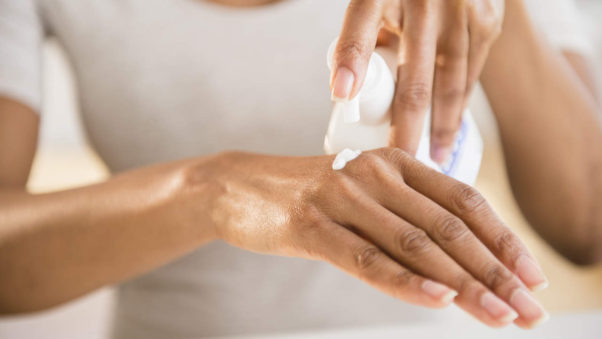How to Repair Your Dry Winter Skin
Every year it amazes my how quickly my skin goes from fine to super dry winter skin. I am dry, cracked and in pain. If I bump my hand on something, I am sure to be bleeding.

When moving from heated homes to heated cars to heated office buildings, our skin experiences less than 4 percent humidity in artificially heated, recirculated air becoming dry and chapped. (Photo: Joseph Pearson/Unsplash)
I asked skincare experts from estheticians to dermatologists for their best tips to help deal with dry winter skin. You can’t just moisturize your skin back to health in the winter, there is a whole process behind fixing your winter skin.
Celeste Hilling
Founder, CEO and product formulator for Skin Authority
When moving from heated homes to heated cars to heated office buildings, our skin experiences less than 4 percent humidity in artificially heated, recirculated air. When skin is denied moisture, two things occur: surface skin becomes dehydrated and chapped while beneath the surface, sebaceous glands compensate by producing more oil. The oil and debris become trapped in the dry surface layers. This can lead to breakouts and irritation.
To counteract this onset of winter skin blahs:
- Daily cleansing: Avoid the temptation to take hot showers as the heat will further dehydrate skin. Keep temperatures lukewarm and exfoliate from head to toe to slough off dead skin cells. Use a cleanser with small, gentle micro-beads versus large scrubbing particles, which can damage fragile skin. Apply a body moisturizer with anti-inflammatory ingredients (shea butter, aloe, olive oil) as soon as you step out of the shower to seal in moisture.
- Exfoliation: Don’t be afraid to exfoliate your face. Regular facial exfoliation speeds up the cell turnover process, which allows the body to produce moisture-bearing properties like hyaluronic acid. Exfoliation also helps plump the skin by churning up elastin and collagen production. I recommend using a resurfacing agent like glycolic acid. Commonly derived from sugar cane, glycolic acid gently dissolves dead surface skin cells, instead of peeling or scrubbing, signaling the body to replace them with new, plump ones.
- Masks: Masks play an important role in restoring nutrients and protective antioxidants the help skin fight effects of overexposure to cold, dry winter air. Try applying a mask of eucalyptus, clay and sulphur once a week to put nutrients and moisture back into your skin while fighting inflammation
- Protection: Snow or sun, don’t forget sunscreen! Apply a full spectrum, moisturizing sunscreen daily to all exposed skin, which often includes our faces, neck, ears, décolletage, hands and forearms.
- Vitamin D: Lack of sun exposure and shorter days lead to less Vitamin D production. Vitamin D is a key hormone needed for strong immune function. Apply a topical Vitamin D serum daily under sunscreen to give the skin a daily dose of D.
Ellen Lange
Esthetician and founder of Ellen Lange Skin Science
Our bodies are like tea kettles constantly giving off steam. We want to lock in moisture, which helps keeps the skin hydrated. Creams should provide moisturizers and also an occlusive barrier to helps enhance the skin’s natural barrier. Hylauronic acid serums are good for attracting and holding moisture. I also keep a pot of Crisco in my bathroom for my hands. I have sensitive skin and it seems be on the few products that does not burn or sting my cracked hands during the winter.
During the cold dry winter months it is essential to peel your skin so your favorite cream or treatment can really be effective. When you remove the top dull outer most layers of the skin, these products can actually reach the skin and work better. In addition, by eliminating the dry uneven layer of skin, cosmetics glide on more smoothly, making it less likely for the makeup to get caught in the pores and fine lines.
Peeling must be done on a regular basis because your skin regenerates itself about every 30 days. Then I just apply a little bronzing powder, a favorite lip gloss and mascara!
Sinead Norenius
Esthetician and founder of Beautisol
Dry skin needs lipids and oils, so look for ingredients like safflower oil, jojoba oil, grape seed extract, shae butter, borage oil or evening primrose oil. All of these ingredients are extra nourishing and rich in vitamins and helps prevents water loss in the skin cells.
For super hydration (meaning water, not oil) look from products that have a high concentration of hyaluronic acid. Think of this ingredient as your “big gulp” of moisture.
Avery Kuflik, MD
Board-certified dermatoligist
As weather conditions change, our skin care routine should change too. For example, in the winter we should use an ointment moisturizer that is oil-based, whereas in the summer we should use a moisturizer that is water-based. This is because the oil-based moisturizer will create a protective layer on the skin that retains more moisture than a water-based moisturizer.
Also, don’t forget the lips! They lose moisture too in the cold weather and need nurturing.
Written by Christina of 15 Minute Beauty

This article was written by the guest author listed at the end of the article.




